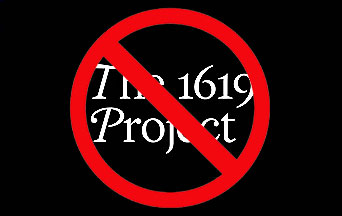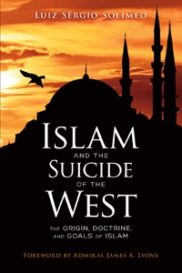
On August 18, 2019, The New York Times Magazine featured The 1619 Project. It set off a debate that resonates from the halls of academe to the streets of America.
1619 was so significant that The New York Post began a story about the 2020 riots with the following:
“America is burning. Rioters set fire to police stations and restaurants. Looters have ravaged shops from coast to coast. And now they’re coming for the statues—not just of Confederate generals, but the republic’s Founders, including George Washington, whose statue was torn down in Portland, Ore.”
“Call them the 1619 riots.”
Nikole Hannah-Jones, the guiding force behind 1619, reportedly had a simple response. “It would be an honor. Thank you.”
Calling Marxism by Its Right Name
Dr. Mary Grabar’s Debunking the 1619 Project: Exposing the Plan to Divide America is required reading for anyone battling Critical Race Theory. She has assembled sufficient evidence to convince anyone whose mind isn’t already closed.
Currently, Dr. Grabar is a resident fellow at the Alexander Hamilton Institute for the Study of Western Civilization. She has experienced the ire of leftist academia in the nearly twenty years since she earned her PhD. in 2002.
She knows about Marxism and its ill effects. She was two when her parents escaped Communist Yugoslavia, eventually relocating to Rochester, New York. Her webpage is a clearinghouse for authors who reflect her anti-totalitarian worldview.
A Tale of Oppression
The first sentence in The 1619 Project conveys its overall tone.
Eternal and Natural Law: The Foundation of Morals and Law
“Out of slavery—and the anti-black racism it required—grew nearly everything that has truly made America exceptional: its economic might, its industrial power, its electoral system, diet and popular music, the inequities of its public health and education, its astonishing penchant for violence, its income inequality, the example it sets for the world as a land of freedom and equality, its slang, its legal system and the endemic racial fears and hatreds that continue to plague it to this day.”
This reading of history places slavery as the cause of everything in the Marxists’ roll of America’s faults. Such distortions feed a simplistic narrative that makes American history a tale of oppression.
The Inquiry Model
1619 is designed to work inside a faulty teaching method called the “inquiry model.” Over the last twenty years, high school history classes have all utilized this model.
It works like this. Teachers provide short readings, photographs or snippets of film to students. The students examine these with a “critical” eye to determine the author’s point of view and biases. Presumably, the student can then separate facts from the writers’ opinions. Then, the students express their views prompted by a series of open-ended questions.
The inquiry model assumes students will form independent opinions like professional historians. In the real world, most students get credit by parroting their teacher’s views.
“Evidence” Leading to a Pre-Determined Conclusion
Students are not professional historians, nor are Mrs. Hannah Jones and the vast majority of 1619’s contributors. Actual historians spend years with their topics. The “inquiry model” expects junior high and high school students to create informed opinions based on two, three, or even a half-dozen highly edited “sources.”
The 1619 Project’s “evidence” points to pre-determined conclusions. Consider this passage from the introductory essay.
 Learn All About the Prophecies of Our Lady of Good Success About Our Times
Learn All About the Prophecies of Our Lady of Good Success About Our Times
“In August 1619, just 12 years after the English settled Jamestown, Va., one year before the Puritans landed at Plymouth Rock and some 157 years before the English colonists even decided they wanted to form their own country, the Jamestown colonists bought 20 to 30 enslaved Africans from English pirates. The pirates had stolen them from a Portuguese slave ship that had forcibly taken them from what is now the country of Angola. Those men and women who came ashore on that August day were the beginning of American slavery.”
Multiple Sins of Omission
Dr. Grabar accuses 1619 of omitting so much information that its grains of truth become misleading.
“How did these Africans come to be on the Portuguese ship in the first place?” she asks. “Hannah-Jones refers to the ‘Portuguese slave ship that had forcibly taken them from what is now the country of Angola.’ Here, as elsewhere in The Project, she couples a distortion of American history with the romanticization of West African history.”
Dr. Grabar adds the missing information.
“Honest black intellectuals such as Thomas Sowell, without ignoring the suffering of slaves in America, acknowledged that West Africa was a great slave-trading region ‘before, during, and after the white man arrived’ and that ‘[i]t was the Africans who enslaved their fellow Africans.’” Carter Woodson (1875-1950), revered as a pioneer in the study of African-American history, echoes Dr. Sowell’s conclusions. “Slavery was once the normal condition of a majority of the inhabitants of the world.” Dr. Grabar then cites the work of another acclaimed African-American historian. John Hope Franklin’s first book, The Free Negro in North Carolina (1943), describes an 1833 North Carolina Case in which the court decided that free blacks were citizens of the state and had the right to own slaves.
Science Confirms: Angels Took the House of Our Lady of Nazareth to Loreto
Indeed, competent historians describe the slave trade in excruciating detail. Mrs. Hannah-Jones deliberately omits context, implying that England’s North American colonies and, eventually, the United States were uniquely guilty of this “original sin.”
The Fruit of a Diseased Tree
Dr. Grabar traces 1619’s analysis of slavery to the work of Lerone Bennet. In a speech at Georgia Tech, Mrs. Hannah-Jones remembered her tenth-grade teacher giving her a copy of Mr. Bennett’s 1961 book, Before the Mayflower. The paragraph from 1619 above echoes Mr. Bennet’s book.
“A year before the arrival of the celebrated “Mayflower,” 113 years before the birth of George Washington, 244 years before the signing of the Emancipation Proclamation, this ship sailed into the harbor at Jamestown, Virginia, and dropped anchor into the muddy waters of history. It was clear to the men who received this “Dutch man of War” that she was no ordinary vessel. What seems unusual today is that no one sensed how extraordinary she was. Few ships, before or since, have unloaded a more momentous cargo.”
Dr. Grabar described the book’s impact on the young Nikole. “One can imagine the impact…on a sixteen-year-old girl…. [She] latched onto her teacher, and onto this writer who coined the term ‘Black Power’ and would be eulogized in his February 16, 2018, New York Times obituary as “a leading scholarly voice during the racial ferment of the 1960s.”
No Neutral Ground
This is the distorted context of the 1619 Project. Everyone from the “World Socialists” to Rush Limbaugh decried 1619. Noted historians refuted it. A group of African American historians set up “1776 Unites” to counteract it.
However, that critical reaction has not prevented many schools and school districts—estimates range from 2,500 to 3,500—from feeding it to their students.
FREE READ: A Pastoral Revolution
The Pulitzer Center, an organization that provides free 1619 related lessons online, gives an example. “One district that has led the charge in this work over the past year has been Buffalo Public Schools (BPS) in Buffalo, New York. The Office of Culturally and Linguistically Responsive Initiatives (CLRI) at BPS has successfully created a rich array of lessons for students in grades 7-12 that draw from 1619 materials and expand upon the project’s mission of inquiry and justice for its students.”
The Value of Debunking 1619
Debunking the 1619 Project is helpful to anyone trying to defend their children’s schools from 1619 and Critical Race Theory. Like Dr. Grabar’s earlier work, Debunking Howard Zinn, this scholarly yet readable account will help concerned parents, grandparents and community members hone fact-based arguments. These arguments will be able to carry the day at public meetings and the offices of ill-informed administrators.
FREE READ: Islam and the Suicide of the West
The book should also be of great value to teachers who face pressures to teach 1619 as fact. Over two thousand schools or school districts placed their official imprimaturs on 1619. Many other administrators appear quite ready to jump on the CRT bandwagon. Many teachers are reluctant to proclaim the “anti-racist” message, fearing being labeled as a racist. No teacher’s career can withstand such charges. Debunking 1619 gives them an academically defensible leg upon which they can stand.
Only One Regret
This reviewer can only imagine one way in which this book could be more on-target. Much of Chapter Six—“A History Neither New nor True”—describes the African slave trade and how it came to be. It includes passages like this quoting from the work of historian David Brion Davis. “The Arabs and other Muslims, who ‘were the first people to develop a specialized long-distance slave trade from sub-Saharan Africa,’ were also ‘the first people to view blacks as suited by nature for the lowest and most degrading forms of bondage.’”
An accurate rendering of the history of slavery should mention the influence of the Catholic Church. As the Church gained credibility in the Roman Empire, the once common institution of slavery decreased until it was finally abolished in medieval Europe. When slavery reared its ugly head in the New World, Catholic figures—notably Saint Junipero Serra and Saint Peter Claver—resisted it.
Indeed, Catholic teaching recognizing all people created in the image and likeness of God represents the true vision of society contrary to Critical Race Theory. It teaches the harmony of the races rather than the class struggle dialectics that destroy society.
This one caveat notwithstanding, this is a most valuable and important book.
Photo Credit: © Sylfida – stock.adobe.com

